Analyzing Spatial and Temporal User Behavior in Participatory Sensing
Abstract
1. Introduction
2. Related Works
2.1. Volunteered Geographic Information and Participatory Sensing
2.2. An Analysis of the Selected Participatory Sensing Applications and Frameworks
2.3. Participants’ Spatial and Temporal Behaviors in Participatory Sensing
3. The Citizense Framework
- the campaign objects, which hold all the details of the different participatory sensing campaigns such as context condition, the list of atomic sensing task, types of data to collect, and incentives for the data collector;
- the campaign manager, which allows campaign authors to create campaigns (i.e., campaign objects) using an intuitive graphical user interface and to visualize the results;
- the campaign server, which serves data collectors with campaigns, processes and stores the submissions, and sends real-time feedback to the data collectors;
- the mobile application, which receives campaigns (i.e., campaign objects), visualizes these upon request of the data collector, and finally deliver the collected data to the campaign server.
3.1. New Features of the Citizense Framework
- Extension of the types of data collected by the framework: The Citizense framework is now capable of collecting different types of sensory data (i.e., WiFi measurement, GPS location), multimedia content (i.e., picture), date and time input. This extension significantly improves the flexibility and reusability of the framework as it allows campaign authors to combine various types of data into their campaigns.
- The implementation of real-time feedback: Campaign authors are now able to manually validate each submission (after the automatic validation performed by the campaign server based on submission’s location and time), define the status of each submission (e.g., accepted, rejected, pending), add text annotation and send feedback to a single data collector and/or all data collectors through the web-based result visualizer. The inclusion of feedback in Citizense framework is of paramount importance as it effectively engages the data collectors. On a higher level, data collectors experience the transparency of the system [64] and realize their data contribution will be taken seriously [65].
- The selection of data collectors based on their user profiles: Campaign authors can intuitively and easily define the filters for selecting the data collectors. These filters include static information (i.e., gender, postal code) and dynamic information (i.e., age, previous experience using the Citizense framework) of the data collectors. Combined with the location and time filters previously implemented, the framework now has flexible and rigorous control on the selection of data collectors, aiming to improve the quality of the collected results.
- The new input method aims to facilitate the participation of users with disabilities: the Citizense mobile application allows data collectors to speak into the device’s microphone in order to use almost all features of the mobile device (e.g., downloading campaigns, selecting a campaign, inputting text). This input method significantly lowers the barriers for participants with disabilities, thereby making the Citizense framework more inclusive.
3.2. The Technical Testing
4. The Real-World Deployment of the Citizense Framework
4.1. The Goals of the Deployment
4.2. The Participatory Sensing Process Using Citizense Framework
4.2.1. Creating Campaigns
4.2.2. Participating in Campaigns
4.3. The Setup of the Deployment
5. Results and Discussion
5.1. Participation Results
5.2. Effectiveness of Citizense for Collecting Geographic and General Information
5.3. Temporal User Behavior: Frequency of Use
5.4. Temporal User Behavior: Distribution of Use
5.5. Spatial User Behavior
5.6. Limitations
6. Conclusions and Future Work
6.1. Conclusions
6.2. Future Work
Author Contributions
Funding
Conflicts of Interest
References
- Comber, A.; Schade, S.; See, L.; Mooney, P.; Foody, G. Semantic analysis of citizen sensing, crowdsourcing and VGI. In Proceedings of the 17th AGILE International Conference, “Connecting a Digital Europe Through Location and Place”, Castellón, Spain, 3–6 June 2014. [Google Scholar]
- Goodchild, M.F. Citizens as sensors: The world of volunteered geography. GeoJournal 2007, 69, 211–221. [Google Scholar] [CrossRef]
- Haklay, M. How good is volunteered geographical information? A comparative study of OpenStreetMap and Ordnance Survey datasets. Environ. Plan. B Plan. Des. 2010, 37, 682–703. [Google Scholar] [CrossRef]
- Guo, B.; Wang, Z.; Yu, Z.; Wang, Y.; Yen, N.Y.; Huang, R.; Zhou, X. Mobile crowd sensing and computing: The review of an emerging human-powered sensing paradigm. ACM Comput. Surv. (CSUR) 2015, 48, 7. [Google Scholar] [CrossRef]
- Sherchan, W.; Jayaraman, P.P.; Krishnaswamy, S.; Zaslavsky, A.; Loke, S.; Sinha, A. Using on-the-move mining for mobile crowdsensing. In Proceedings of the 2012 IEEE 13th International Conference on Mobile Data Management (MDM), Bengaluru, India, 23–26 July 2012; pp. 115–124. [Google Scholar]
- Maisonneuve, N.; Stevens, M.; Niessen, M.E.; Steels, L. NoiseTube: Measuring and mapping noise pollution with mobile phones. In Information Technologies in Environmental Engineering; Springer: Berlin/Heidelberg, Germany, 2009; pp. 215–228. [Google Scholar]
- Schweizer, I.; Bärtl, R.; Schulz, A.; Probst, F.; Mühläuser, M. NoiseMap-real-time participatory noise maps. In Proceedings of the Second International Workshop on Sensing Applications on Mobile Phones, Bethesda, MD, USA, 28 June–1 July 2011. [Google Scholar]
- Mosquito Alert. 2018. Available online: http://www.mosquitoalert.com/ (accessed on 30 June 2018).
- Malek, R.; Tattoni, C.; Ciolli, M.; Corradini, S.; Andreis, D.; Ibrahim, A.; Mazzoni, V.; Eriksson, A.; Anfora, G. Coupling Traditional Monitoring and Citizen Science to Disentangle the Invasion of Halyomorpha halys. ISPRS Int. J. Geo-Inf. 2018, 7, 171. [Google Scholar] [CrossRef]
- Hasenfratz, D.; Saukh, O.; Sturzenegger, S.; Thiele, L. Participatory air pollution monitoring using smartphones. In Proceedings of the 1st International Workshop on Mobile Sensing: From Smartphones and Wearables to Big Data, Beijing, China, 16–20 April 2012. [Google Scholar]
- Mendez, D.; Perez, A.J.; Labrador, M.A.; Marron, J.J. P-sense: A participatory sensing system for air pollution monitoring and control. In Proceedings of the 2011 IEEE International Conference on Pervasive Computing and Communications Workshops (PERCOM Workshops), Seattle, WA, USA, 21–25 March 2011; pp. 344–347. [Google Scholar]
- Khan, W.Z.; Xiang, Y.; Aalsalem, M.Y.; Arshad, Q. Mobile phone sensing systems: A survey. IEEE Commun. Surv. Tutor. 2013, 15, 402–427. [Google Scholar] [CrossRef]
- Tilak, S. Real-world deployments of participatory sensing applications: Current trends and future directions. ISRN Sens. Netw. 2013, 2013, 583165. [Google Scholar] [CrossRef]
- Khoi, N.M.; Rodríguez-Pupo, L.E.; Casteleyn, S. Citizense—A generic user-oriented participatory sensing framework. In Proceedings of the 2017 International Conference on Selected Topics in Mobile and Wireless Networking (MoWNeT), Avignon, France, 17–19 May 2017; pp. 1–8. [Google Scholar]
- Silva, T.H.; De Melo, P.O.V.; Almeida, J.M.; Loureiro, A.A. Large-scale study of city dynamics and urban social behavior using participatory sensing. IEEE Wirel. Commun. 2014, 21, 42–51. [Google Scholar] [CrossRef]
- Wilkinson, D.M.; Huberman, B.A. Assessing the value of coooperation in wikipedia. arXiv, 2007; arXiv:cs/0702140. [Google Scholar]
- Callahan, E.S.; Herring, S.C. Cultural bias in Wikipedia content on famous persons. J. Am. Soc. Inf. Sci. Technol. 2011, 62, 1899–1915. [Google Scholar] [CrossRef]
- Royal, C.; Kapila, D. What’s on Wikipedia, and what’s not...? Assessing completeness of information. Soc. Sci. Comput. Rev. 2009, 27, 138–148. [Google Scholar] [CrossRef]
- Hochmair, H.H.; Zielstra, D. Analysing user contribution patterns of drone pictures to the dronestagram photo sharing portal. J. Spat. Sci. 2015, 60, 79–98. [Google Scholar] [CrossRef]
- Juhász, L.; Hochmair, H.H. User contribution patterns and completeness evaluation of Mapillary, a crowdsourced street level photo service. Trans. GIS 2016, 20, 925–947. [Google Scholar] [CrossRef]
- Hughes, D.; Coulson, G.; Walkerdine, J. Free riding on Gnutella revisited: The bell tolls? IEEE Distrib. Syst. Online 2005, 6. [Google Scholar] [CrossRef]
- Khoi, N.M.; Casteleyn, S.; Moradi, M.M.; Pebesma, E. Do Monetary Incentives Influence Users’ Behavior in Participatory Sensing? Sensors 2018, 18, 1426. [Google Scholar] [CrossRef] [PubMed]
- Neis, P.; Zielstra, D. Recent developments and future trends in volunteered geographic information research: The case of OpenStreetMap. Future Internet 2014, 6, 76–106. [Google Scholar] [CrossRef]
- Guo, B.; Yu, Z.; Zhou, X.; Zhang, D. From participatory sensing to mobile crowd sensing. In Proceedings of the 2014 IEEE International Conference on IEEE Pervasive Computing and Communications Workshops (PERCOM Workshops), Budapest, Hungary, 24–28 March 2014; pp. 593–598. [Google Scholar]
- Wang, J.; Liu, X.; Lu, R.; Wang, C.; Wang, C. Poster: Interactive Platform for Urban Bird Studies Using Participatory Sensing. In Proceedings of the 14th Annual International Conference on Mobile Systems, Applications, and Services Companion, Singapore, 25–30 June 2016; p. 85. [Google Scholar]
- Aubry, E.; Silverston, T.; Lahmadi, A.; Festor, O. CrowdOut: A mobile crowdsourcing service for road safety in digital cities. In Proceedings of the 2014 IEEE International Conference on Pervasive Computing and Communications Workshops (PERCOM Workshops), Budapest, Hungary, 24–28 March 2014; pp. 86–91. [Google Scholar]
- Hussin, M.F.B.; Jusoh, M.H.; Sulaiman, A.A.; Aziz, M.Z.A.; Othman, F.; Ismail, M.H.B. Accident reporting system using an iOS application. In Proceedings of the 2014 IEEE Conference on Systems, Process and Control (ICSPC), Kuala Lumpur, Malaysia, 12–14 December 2014; pp. 13–18. [Google Scholar]
- Open Signal. 2018. Available online: https://opensignal.com/ (accessed on 30 June 2018).
- Miluzzo, E.; Papandrea, M.; Lane, N.D.; Sarroff, A.M.; Giordano, S.; Campbell, A.T. Tapping into the vibe of the city using vibn. In Proceedings of the 1st International Symposium on Social and Community Intelligence (SCI’11), co-located with 13th International Conference on Ubiquitous Computing (Ubicomp’11), Beijing, China, 18 September 2011. [Google Scholar]
- Tangmunarunkit, H.; Hsieh, C.K.; Longstaff, B.; Nolen, S.; Jenkins, J.; Ketcham, C.; Selsky, J.; Alquaddoomi, F.; George, D.; Kang, J.; et al. Ohmage: A general and extensible end-to-end participatory sensing platform. ACM Trans. Intell. Syst. Technol. (TIST) 2015, 6, 38. [Google Scholar] [CrossRef]
- Brunette, W.; Sundt, M.; Dell, N.; Chaudhri, R.; Breit, N.; Borriello, G. Open data kit 2.0: Expanding and refining information services for developing regions. In Proceedings of the 14th Workshop on Mobile Computing Systems and Applications, Jekyll Island, Georgia, 26–27 February 2013; p. 10. [Google Scholar]
- Pavlov, D.V. Hive: An Extensible and Scalable Framework for Mobile Crowdsourcing. Ph.D. Thesis, Imperial College London, London, UK, 2013. [Google Scholar]
- Restuccia, F.; Das, S.K.; Payton, J. Incentive mechanisms for participatory sensing: Survey and research challenges. ACM Trans. Sens. Netw. (TOSN) 2016, 12, 13. [Google Scholar] [CrossRef]
- Gao, H.; Liu, C.H.; Wang, W.; Zhao, J.; Song, Z.; Su, X.; Crowcroft, J.; Leung, K.K. A survey of incentive mechanisms for participatory sensing. IEEE Commun. Surv. Tutor. 2015, 17, 918–943. [Google Scholar] [CrossRef]
- Reddy, S.; Estrin, D.; Srivastava, M. Recruitment framework for participatory sensing data collections. In Proceedings of the International Conference on Pervasive Computing, Helsinki, Finland, 17–20 May 2010; pp. 138–155. [Google Scholar]
- Reddy, S.; Shilton, K.; Burke, J.; Estrin, D.; Hansen, M.; Srivastava, M. Using context annotated mobility profiles to recruit data collectors in participatory sensing. In Proceedings of the International Symposium on Location-and Context-Awareness, Tokyo, Japan, 7–8 May 2009; pp. 52–69. [Google Scholar]
- Havlik, D.; Egly, M.; Huber, H.; Kutschera, P.; Falgenhauer, M.; Cizek, M. Robust and trusted crowd-sourcing and crowd-tasking in the Future Internet. In Proceedings of the International Symposium on Environmental Software Systems, Neusiedl am See, Austria, 9–11 October 2013; pp. 164–176. [Google Scholar]
- Li, R.Y.; Liang, S.H.; Lee, D.W.; Byon, Y.J. TrafficPulse: A mobile GISystem for transportation. In Proceedings of the First ACM SIGSPATIAL International Workshop on Mobile Geographic Information Systems, Redondo Beach, CA, USA, 6 November 2012; pp. 9–16. [Google Scholar]
- Kazemi, L.; Shahabi, C. A privacy-aware framework for participatory sensing. ACM Sigkdd Explor. Newslett. 2011, 13, 43–51. [Google Scholar] [CrossRef]
- Rana, R.K.; Chou, C.T.; Kanhere, S.S.; Bulusu, N.; Hu, W. Ear-phone: An end-to-end participatory urban noise mapping system. In Proceedings of the 9th ACM/IEEE International Conference on Information Processing in Sensor Networks, Stockholm, Sweden, 12–16 April 2010; pp. 105–116. [Google Scholar]
- Ruge, L.; Altakrouri, B.; Schrader, A. Soundofthecity-continuous noise monitoring for a healthy city. In Proceedings of the 2013 IEEE International Conference on Pervasive Computing and Communications Workshops (PERCOM Workshops), San Diego, CA, USA, 18–22 March 2013; pp. 670–675. [Google Scholar]
- Silva, T.H.; de Melo, P.O.V.; Viana, A.C.; Almeida, J.M.; Salles, J.; Loureiro, A.A. Traffic condition is more than colored lines on a map: Characterization of waze alerts. In Proceedings of the International Conference on Social Informatics, Kyoto, Japan, 25–27 November 2013; pp. 309–318. [Google Scholar]
- Carreras, I.; Miorandi, D.; Tamilin, A.; Ssebaggala, E.R.; Conci, N. Matador: Mobile task detector for context-aware crowd-sensing campaigns. In Proceedings of the 2013 IEEE International Conference on Pervasive Computing and Communications Workshops (PERCOM Workshops), San Diego, CA, USA, 18–22 March 2013; pp. 212–217. [Google Scholar]
- Higgins, C.I.; Williams, J.; Leibovici, D.G.; Simonis, I.; Davis, M.J.; Muldoon, C.; van Genuchten, P.; O’Hare, G.; Wiemann, S. Citizen observatory web (cobweb): A generic infrastructure platform to facilitate the collection of citizen science data for environmental monitoring. Int. J. Spat. Data Infrastruct. Res. 2016, 11, 20–48. [Google Scholar]
- Mergel, I. Distributed Democracy: Seeclickfix.com for Crowdsourced Issue Reporting. 2018. Available online: https://kops.uni-konstanz.de/handle/123456789/36359 (accessed on 30 June 2018).
- Walravens, N. Validating a business model framework for smart city services: The case of fixmystreet. In Proceedings of the 2013 27th International Conference on Advanced Information Networking and Applications Workshops (WAINA), Barcelona, Spain, 25–28 March 2013; pp. 1355–1360. [Google Scholar]
- Tsampoulatidis, I.; Ververidis, D.; Tsarchopoulos, P.; Nikolopoulos, S.; Kompatsiaris, I.; Komninos, N. ImproveMyCity: An open source platform for direct citizen-government communication. In Proceedings of the 21st ACM international conference on Multimedia, Barcelona, Spain, 21–25 October 2013; pp. 839–842. [Google Scholar]
- Sanchez, L.; Gutierrez, V.; Galache, J.A.; Sotres, P.; Santana, J.R.; Muñoz, L. Engaging Individuals in the Smart City Paradigm: Participatory Sensing and Augmented Reality. Interdiscip. Stud. J. 2014, 3, 129–142. [Google Scholar]
- Mukherjee, T.; Chander, D.; Mondal, A.; Dasgupta, K.; Kumar, A.; Venkat, A. CityZen: A cost-effective city management system with incentive-driven resident engagement. In Proceedings of the 2014 IEEE 15th International Conference on Mobile Data Management (MDM), Brisbane, Australia, 14–18 July 2014; Volume 1, pp. 289–296. [Google Scholar]
- Das, T.; Mohan, P.; Padmanabhan, V.N.; Ramjee, R.; Sharma, A. PRISM: Platform for remote sensing using smartphones. In Proceedings of the 8th International Conference on Mobile Systems, Applications, and Services, San Francisco, CA, USA, 15–18 June 2010; pp. 63–76. [Google Scholar]
- Ra, M.R.; Liu, B.; La Porta, T.F.; Govindan, R. Medusa: A programming framework for crowd-sensing applications. In Proceedings of the 10th International Conference on Mobile Systems, Applications, and Services, Low Wood Bay, Lake District, UK, 25–29 June 2012; pp. 337–350. [Google Scholar]
- Kim, S.; Mankoff, J.; Paulos, E. Sensr: Evaluating a flexible framework for authoring mobile data-collection tools for citizen science. In Proceedings of the 2013 Conference on Computer Supported Cooperative Work, San Antonio, TX, USA, 23–27 February 2013; pp. 1453–1462. [Google Scholar]
- Katsomallos, M.; Lalis, S. EasyHarvest: Supporting the deployment and management of sensing applications on smartphones. In Proceedings of the 2014 IEEE International Conference on Pervasive Computing and Communications Workshops (PERCOM Workshops), Budapest, Hungary, 24–28 March 2014; pp. 80–85. [Google Scholar]
- Massung, E.; Coyle, D.; Cater, K.F.; Jay, M.; Preist, C. Using crowdsourcing to support pro-environmental community activism. In Proceedings of the SIGCHI Conference on Human Factors in Computing Systems, Paris, France, 27 April–2 May 2013; pp. 371–380. [Google Scholar]
- Arakawa, Y.; Matsuda, Y. Gamification mechanism for enhancing a participatory urban sensing: Survey and practical results. J. Inf. Process. 2016, 24, 31–38. [Google Scholar] [CrossRef]
- Jaimes, L.G.; Vergara-Laurens, I.J.; Raij, A. A survey of incentive techniques for mobile crowd sensing. IEEE Internet Things J. 2015, 2, 370–380. [Google Scholar] [CrossRef]
- Shen, Y.T.; Shiu, Y.S.; Liu, W.K.; Lu, P.W. The Participatory Sensing Platform Driven by UGC for the Evaluation of Living Quality in the City. In Proceedings of the International Conference on Human Interface and the Management of Information, Vancouver, BC, Canada, 9–14 July 2017; pp. 516–527. [Google Scholar]
- Grasso, V.; Crisci, A.; Morabito, M.; Nesi, P.; Pantaleo, G. Public crowdsensing of heat waves by social media data. Adv. Sci. Res. 2017, 14, 217–226. [Google Scholar] [CrossRef]
- Li, C.; Liu, Y.; Haklay, M. Participatory soundscape sensing. Landsc. Urban Plan. 2018, 173, 64–69. [Google Scholar] [CrossRef]
- Sultan, J.; Ben-Haim, G.; Haunert, J.H.; Dalyot, S. Extracting spatial patterns in bicycle routes from crowdsourced data. Trans. GIS 2017, 21, 1321–1340. [Google Scholar] [CrossRef]
- Alt, F.; Shirazi, A.S.; Schmidt, A.; Kramer, U.; Nawaz, Z. Location-based crowdsourcing: extending crowdsourcing to the real world. In Proceedings of the 6th Nordic Conference on Human-Computer Interaction: Extending Boundaries, Reykjavik, Iceland, 16–20 October 2010; pp. 13–22. [Google Scholar]
- Geo-C Joint Doctorate Program. Open City Toolkit. 2018. Available online: http://giv-oct.uni-muenster.de:5000/ (accessed on 30 June 2018).
- The Apache Software Foundation. Apache License Version 2.0; The Apache Software Foundation: Forest Hill, MD, USA, 2018. [Google Scholar]
- Panopoulou, E.; Tambouris, E.; Tarabanis, K. Success factors in designing eParticipation initiatives. Inf. Organ. 2014, 24, 195–213. [Google Scholar] [CrossRef]
- Pina, V.; Torres, L.; Royo, S. Comparing online with offline citizen engagement for climate change: Findings from Austria, Germany and Spain. Gov. Inf. Q. 2017, 34, 26–36. [Google Scholar] [CrossRef]
- Budde, M.; Schankin, A.; Hoffmann, J.; Danz, M.; Riedel, T.; Beigl, M. Participatory Sensing or Participatory Nonsense?: Mitigating the Effect of Human Error on Data Quality in Citizen Science. Proc. ACM Interact. Mob. Wearable Ubiquitous Technol. 2017, 1, 39. [Google Scholar] [CrossRef]
- Reddy, S.; Estrin, D.; Hansen, M.; Srivastava, M. Examining micro-payments for participatory sensing data collections. In Proceedings of the 12th ACM International Conference on Ubiquitous Computing, Copenhagen, Denmark, 26–29 September 2010; pp. 33–36. [Google Scholar]
- Anderson, C. The Long Tail: Why the Future of Business Is Selling More for Less; Hyperion: New York, NY, USA, 2006. [Google Scholar]
- Hinz, O.; Eckert, J.; Skiera, B. Drivers of the long tail phenomenon: an empirical analysis. J. Manag. Inf. Syst. 2011, 27, 43–70. [Google Scholar] [CrossRef]
- Pan, B.; Li, X.R. The long tail of destination image and online marketing. Ann. Tour. Res. 2011, 38, 132–152. [Google Scholar] [CrossRef]
- Geiger, R.S.; Halfaker, A. Using edit sessions to measure participation in Wikipedia. In Proceedings of the 2013 Conference on Computer supported cooperative Work, San Antonio, TX, USA, 23–27 February 2013; pp. 861–870. [Google Scholar]
- Wang, Y.; Niiya, M.; Mark, G.; Reich, S.M.; Warschauer, M. Coming of age (digitally): An ecological view of social media use among college students. In Proceedings of the 18th ACM Conference on Computer Supported Cooperative Work & Social Computing, Vancouver, BC, Canada, 14–18 March 2015; pp. 571–582. [Google Scholar]
- Daniels, R.; Mulley, C. Explaining walking distance to public transport: The dominance of public transport supply. J. Transp. Land Use 2013, 6, 5–20. [Google Scholar] [CrossRef]
- Andersen, J.L.E.; Landex, A. Catchment areas for public transport. WIT Trans. Built Environ. 2008, 101, 175–184. [Google Scholar]
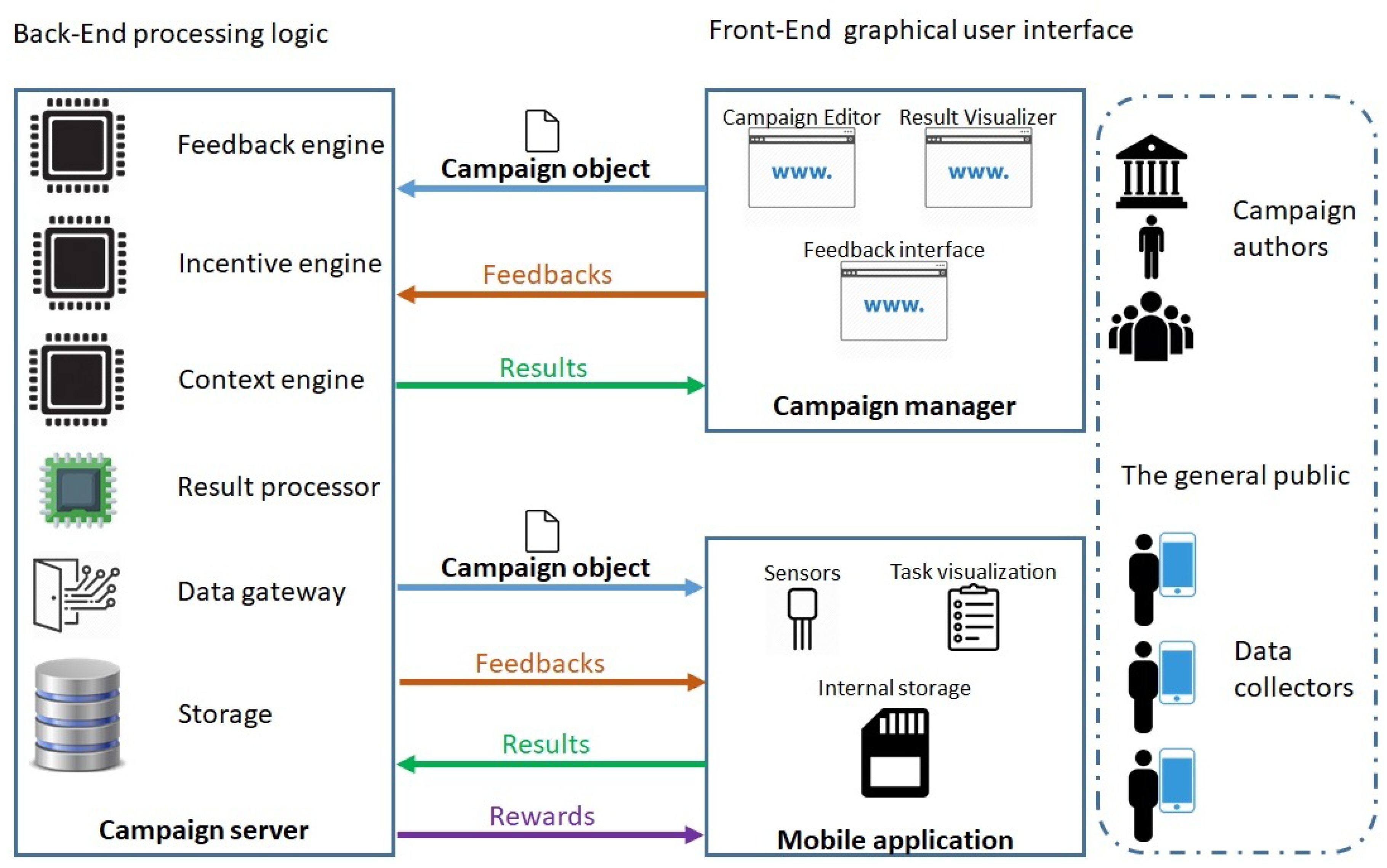
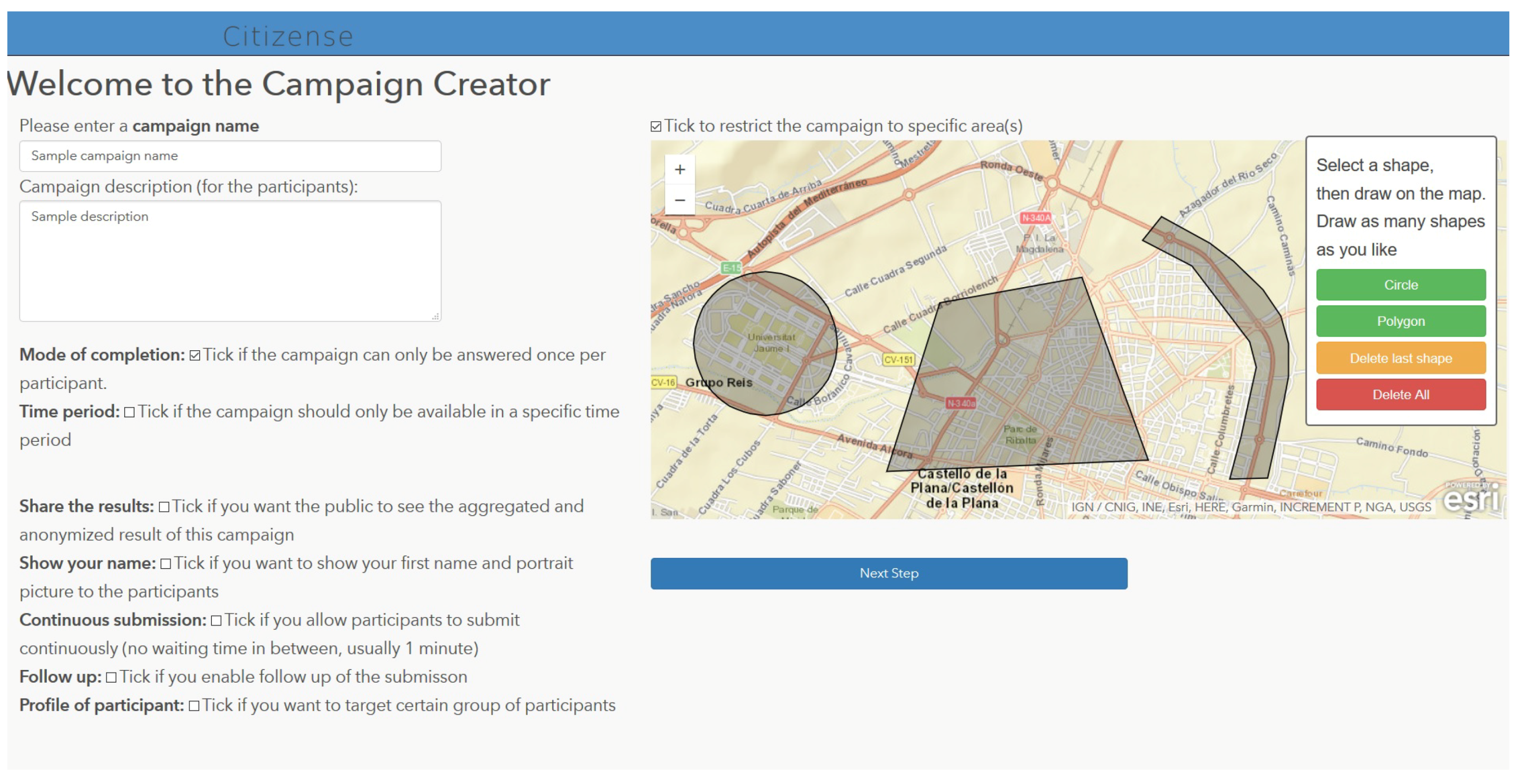
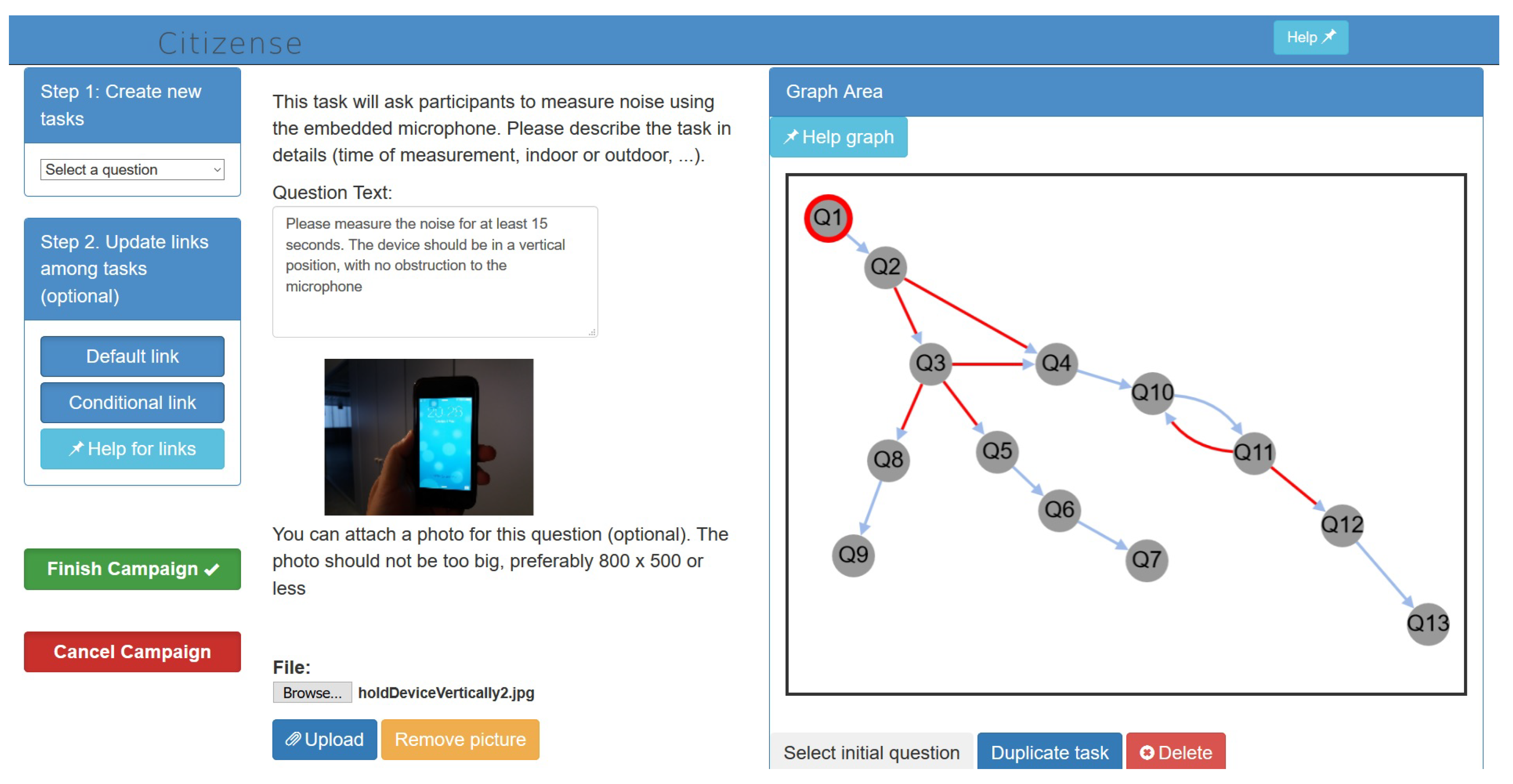
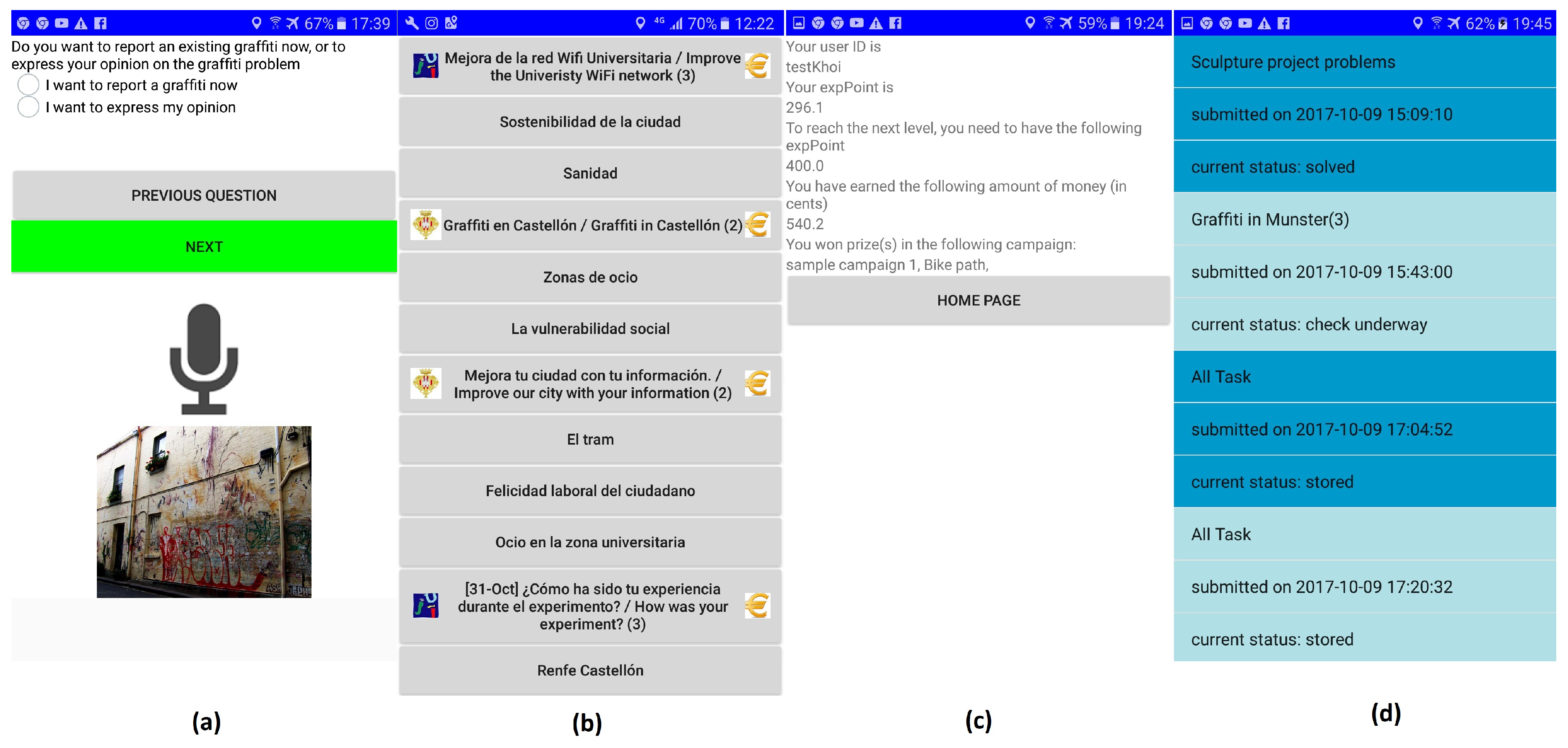
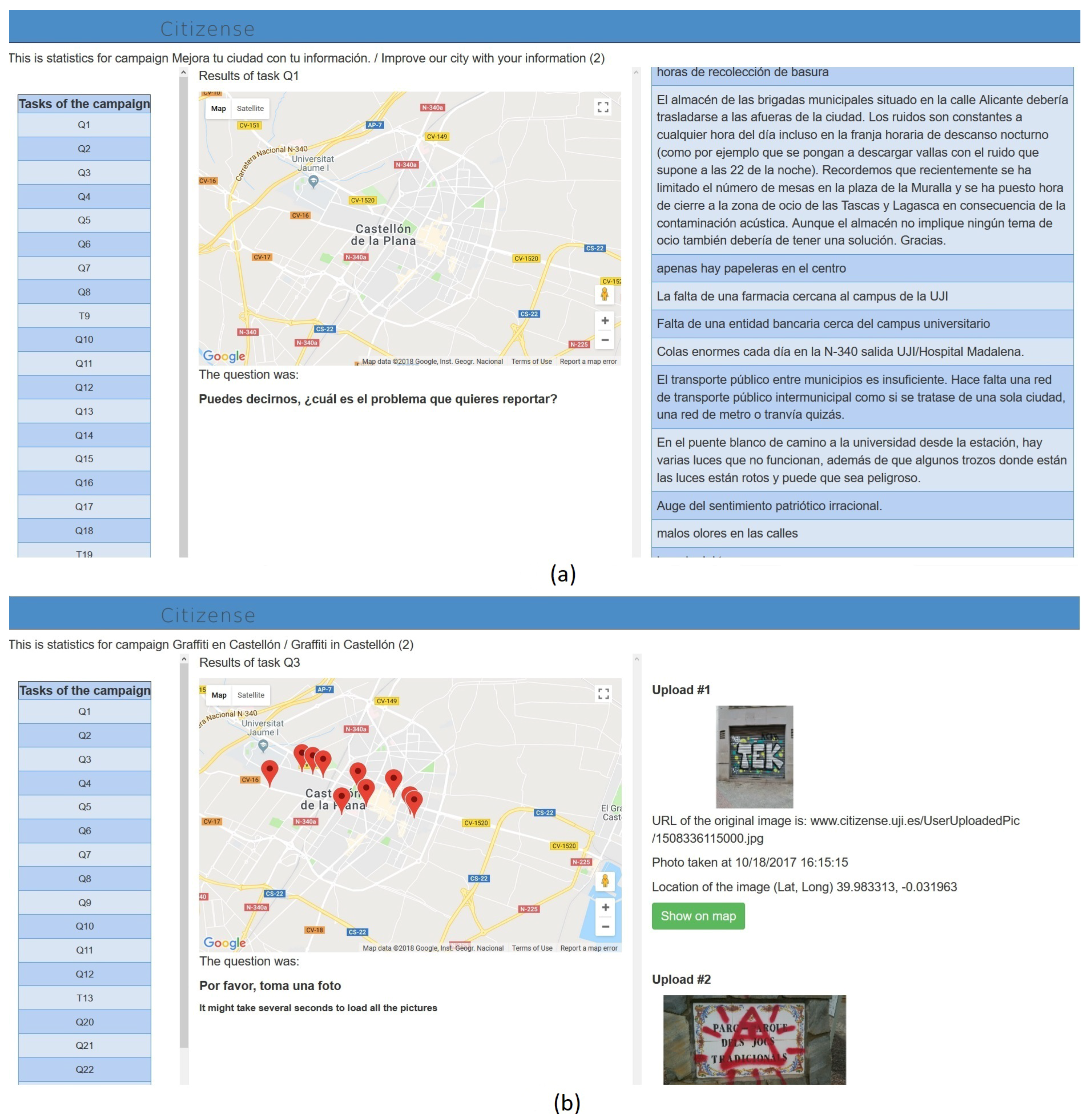

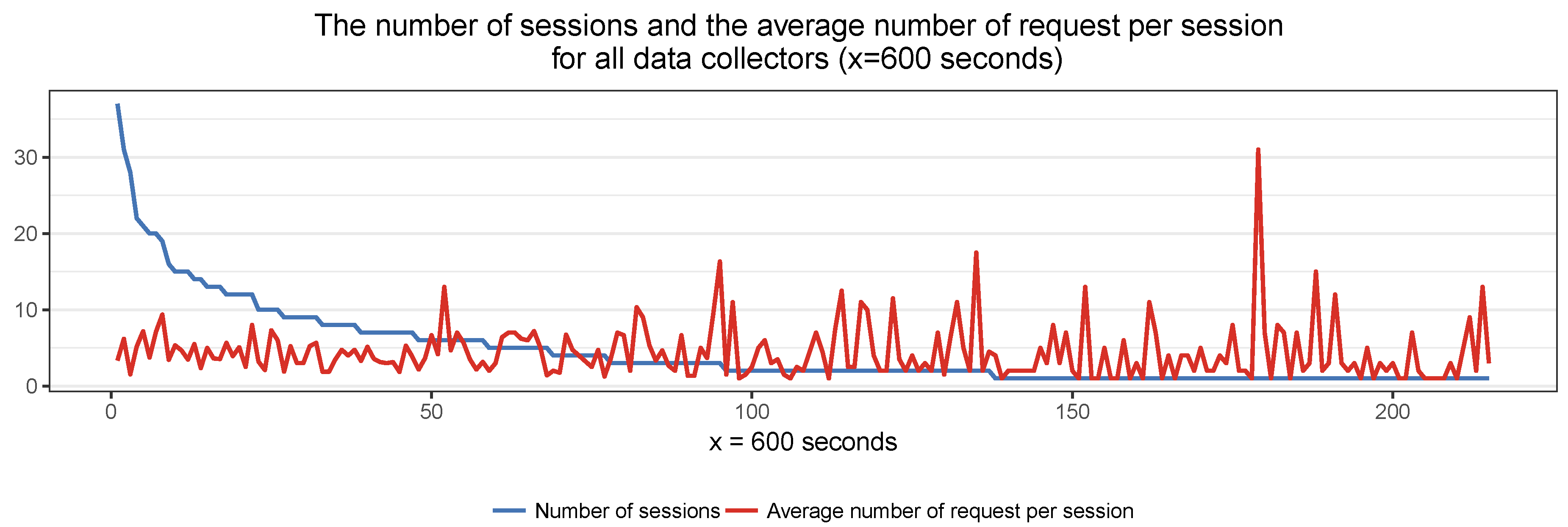
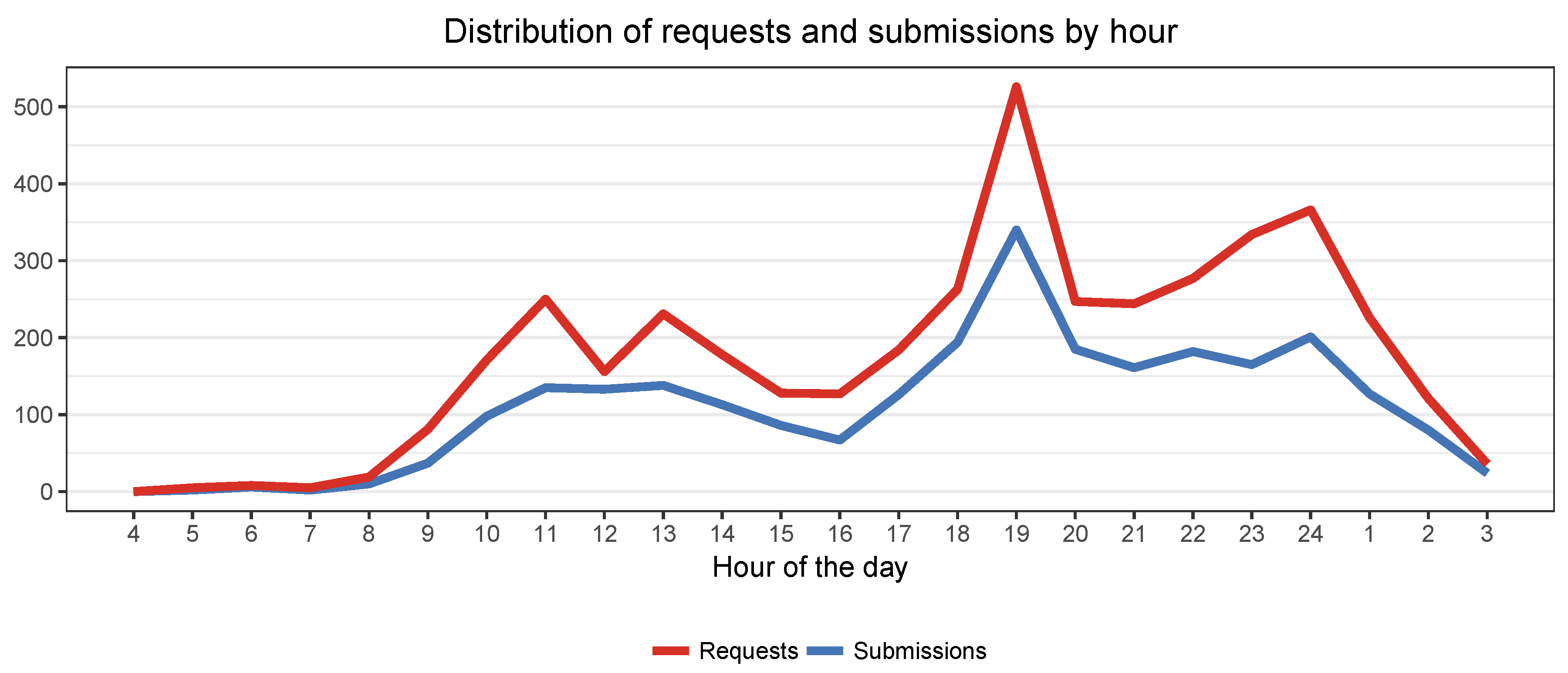
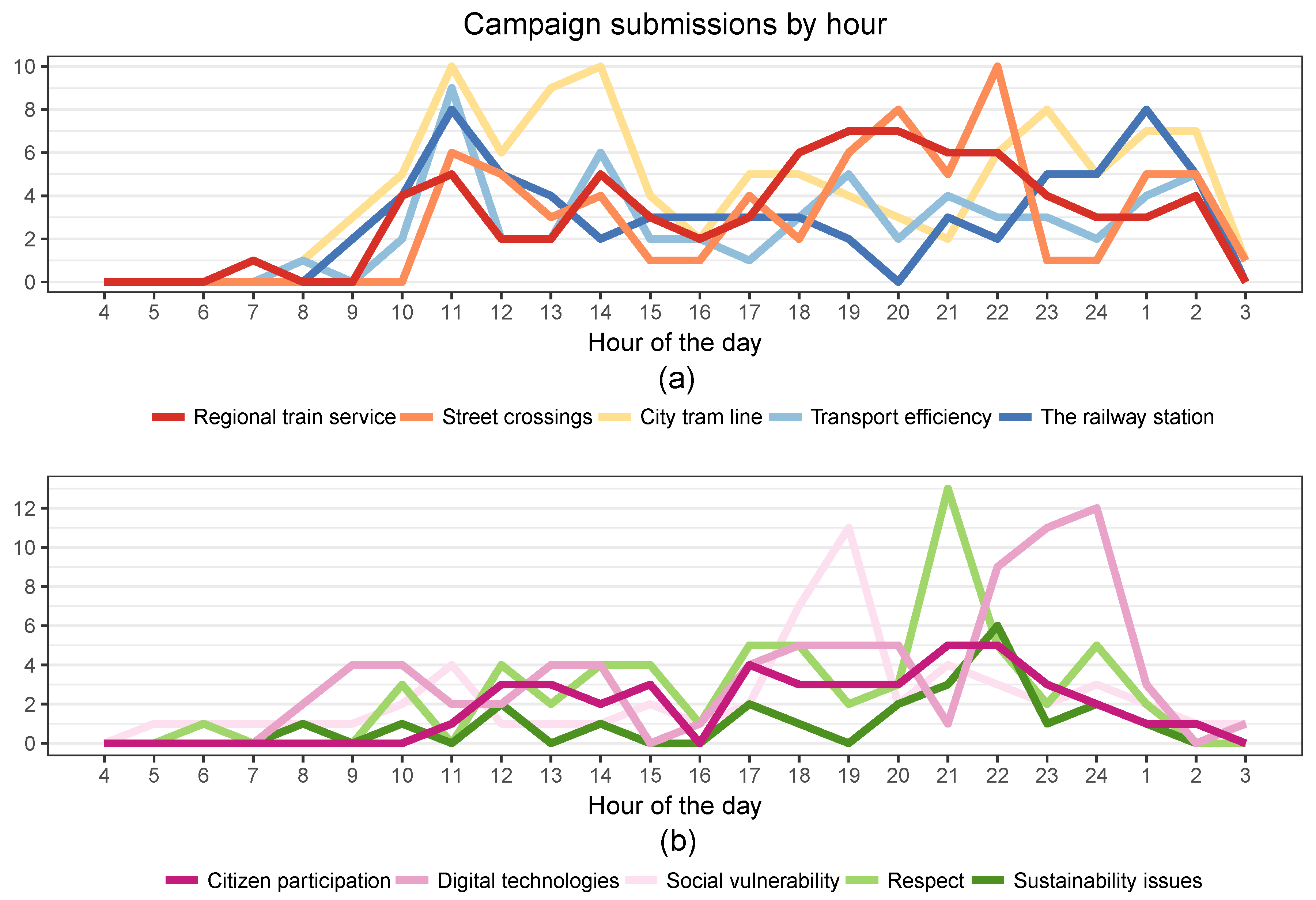

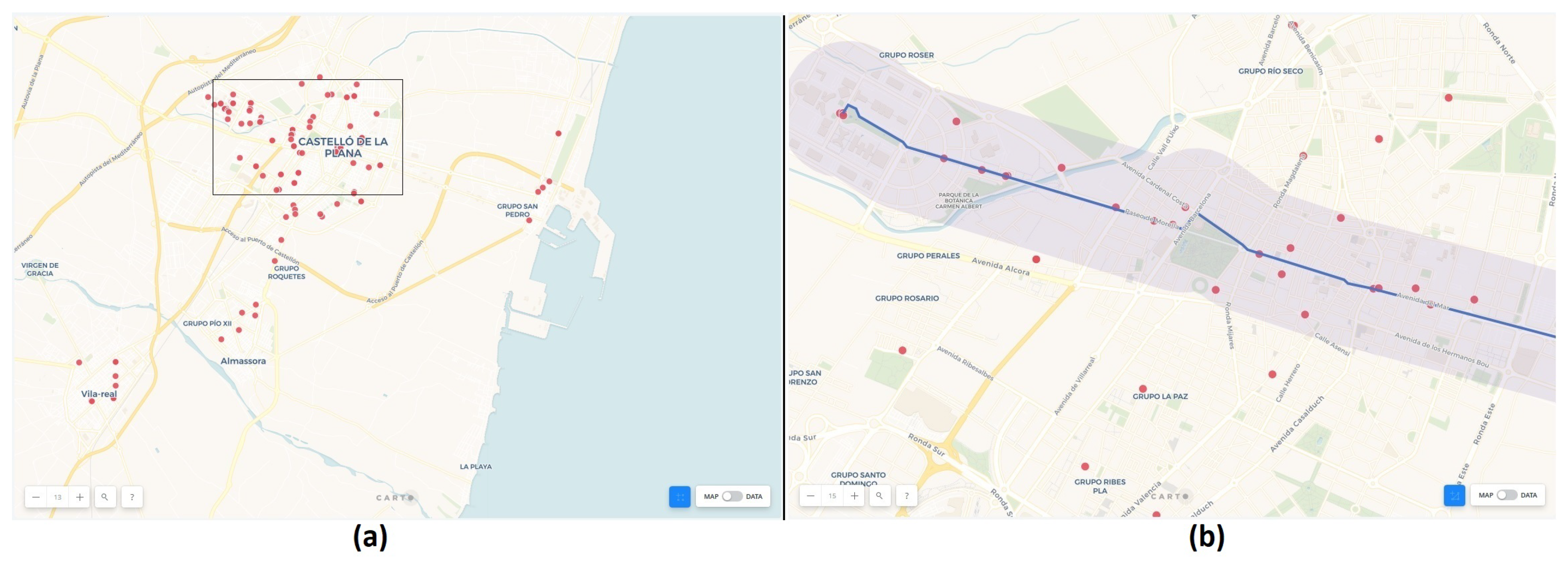
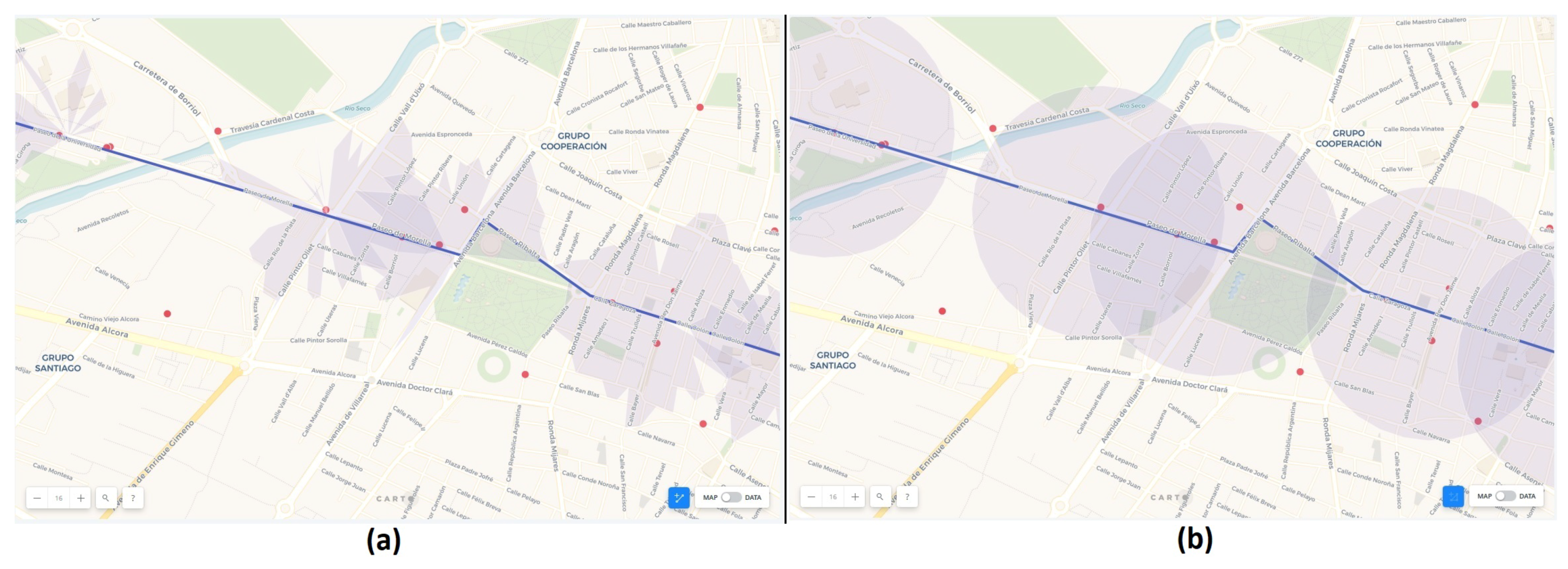
| Name | Time | Theme | Origin | Status | Tool Flexibility | Incentive | Selection Criteria | Result Delivery | Identity of Participants | Campaign Flexibility |
|---|---|---|---|---|---|---|---|---|---|---|
| Earphone [40] | 2010 | Noise | Academia | Prototype | No | Experience point | No | Immediate | Anonymous | No |
| NoiseTube [6] | 2009 | Noise | Academia | Complete | No | No | No | Immediate | Traceable | No |
| SoundOfTheCity [41] | 2013 | Noise | Academia | Prototype | No | No | No | Immediate | Anonymous | No |
| Waze [42] | 2010 | Traffic | Industry | Popular | No | Reputation point, rank | No | Immediate | Traceable | No |
| Matador [43] | 2013 | General | Academia | Prototype | Partial | No | Location, time | Immediate | Unknown | Partial |
| OpenSignal [28] | 2010 | Signal strength | Industry | Popular | No | No | No | Immediate | Anonymous | No |
| COBWEB [44] | 2015 | Environment | Academia | Complete | Partial | No | No | Flexible | Traceable | Partial |
| Bird Watching platform [25] | 2016 | Bird information | Academia | Prototype | No | No | No | Immediate | Unknown | No |
| CrowdOut [26] | 2014 | Road safety | Academia | Prototype | No | No | No | Immediate | Traceable | No |
| SeeClickFix [45] | 2008 | City incidents | Industry | Popular | No | No | No | Immediate | Traceable | No |
| FixMyStreet [46] | 2012 | City incidents | Industry | Popular | No | No | No | Immediate | Traceable | No |
| ImproveMyCity [47] | 2013 | City incidents | Industry | Complete | No | No | No | Flexible | Unknown | No |
| Pulso De La Ciudad [48] | 2014 | City incidents | Academia | Complete | No | No | No | Immediate | Anonymous | No |
| Cityzen [49] | 2014 | City incidents | Academia | Prototype | No | Yes | No | Immediate | Traceable | No |
| PRISM [50] | 2010 | Multiple | Academia | Prototype | Partial | No | Location | Immediate | Anonymous | Partial |
| Medusa [51] | 2012 | Multiple | Academia | Prototype | Partial | Yes | Location, time | Immediate | Traceable | Partial |
| Hive [32] | 2013 | Multiple | Academia | Prototype | Partial | No | Location | Immediate | Traceable | Partial |
| Sensr [52] | 2013 | Multiple | Academia | Prototype | Complete | No | No | Immediate | Anonymous | Partial |
| OpenDataKit [31] | 2013 | Multiple | Academia | Complete | Partial | No | No | Immediate | Anonymous | Partial |
| EasyHarvest [53] | 2014 | Multiple | Academia | Prototype | Partial | No | No | Flexible | Anonymous | Partial |
| Ohmage [30] | 2015 | Multiple | Academia | Complete | Complete | No | No | Immediate | Traceable | Dynamic |
| Citizense [14] | 2017 | Multiple | Academia | Prototype | Complete | Intrinsic, extrinsic | Location, time, user profile | Flexible | Traceable | Dynamic |
| Campaign Title | Number of Submissions | Number of Data Collectors | Geographical Scope | Duration (Days) | Origin | |
|---|---|---|---|---|---|---|
| 1 | Citizen participation | 370 | 195 | Neutral | 20 | Organizer |
| 2 | Improve University’s WiFi | 332 | 147 | Constrained | 20 | Organizer |
| 3 | Graffiti in Castellón | 212 | 125 | Geographically-related | 20 | Organizer |
| 4 | Street animal in the city | 197 | 75 | Geographically-related | 20 | Organizer |
| 5 | University campus | 154 | 113 | Geographically-related | 20 | Organizer |
| 6 | City incidents | 153 | 90 | Geographically-related | 20 | Organizer |
| 7 | Hygienic issues in the city | 117 | 61 | Geographically-related | 20 | Organizer |
| 8 | City’s cycling infrastructure | 105 | 55 | Geographically-related | 20 | Organizer |
| 9 | Professors and teaching methods | 104 | 75 | Neutral | 12 | Participant |
| 10 | Regional train service | 103 | 92 | Geographically-related | 18 | Participant |
| 11 | Leisure destination | 101 | 81 | Neutral | 14 | Participant |
| 12 | Respect | 83 | 75 | Neutral | 19 | Participant |
| 13 | The intermodal station | 76 | 72 | Geographically-related | 20 | Participant |
| 14 | City tram line | 73 | 55 | Geographically-related | 16 | Participant |
| 15 | Transport efficiency | 72 | 68 | Neutral | 18 | Participant |
| 16 | Digital technologies | 64 | 49 | Neutral | 20 | Participant |
| 17 | Street crossings | 61 | 58 | Neutral | 14 | Participant |
| 18 | Nocturnal ambiance in Castellón | 52 | 44 | Geographically-related | 18 | Participant |
| 19 | Sustainability issues | 47 | 42 | Neutral | 19 | Participant |
| 20 | Social vulnerability | 46 | 35 | Neutral | 19 | Participant |
| 21 | Sales promotion | 45 | 29 | Neutral | 20 | Organizer |
| 22 | Food consumption | 41 | 41 | Neutral | 15 | Participant |
| Buffer | Catchment | |||||
|---|---|---|---|---|---|---|
| Campaign Name | Campaign Content | Geographic Buffer | 100 m | 200 m | 400 m | 400 m |
| City tram line | The citizens’ opinions on the tram service | Polyline-The tram route | 52.77% | 55.55% | 61.11% | 52.77% |
| Respect | How people respect each other | Neutral | 7.69% | 7.69% | 7.69% | 7.69% |
| Regional train service | Feedback on the current regional train service | Polyline-The railroad network and Points-The stations | 45.90% | 47.54% | 54.09% | 22.95% |
| Respect | How people respect each other | Neutral | 4.61% | 4.61% | 4.61% | 1.53% |
| The intermodal station | Opinion on the current state of the station and ways to improve it | Point-The station | 36.11% | 41.66% | 47.22% | 44.44% |
| Respect | How people respect each other | Neutral | 0% | 0% | 0% | 0% |
| University campus | How to improve the campus’s infrastructure | Polygon-The university campus | 45.09% | 50.98% | 50.98% | n/a |
| Respect | How people respect each other | Neutral | 6.55% | 6.55% | 6.55% | n/a |
© 2018 by the authors. Licensee MDPI, Basel, Switzerland. This article is an open access article distributed under the terms and conditions of the Creative Commons Attribution (CC BY) license (http://creativecommons.org/licenses/by/4.0/).
Share and Cite
Khoi, N.M.; Casteleyn, S. Analyzing Spatial and Temporal User Behavior in Participatory Sensing. ISPRS Int. J. Geo-Inf. 2018, 7, 344. https://doi.org/10.3390/ijgi7090344
Khoi NM, Casteleyn S. Analyzing Spatial and Temporal User Behavior in Participatory Sensing. ISPRS International Journal of Geo-Information. 2018; 7(9):344. https://doi.org/10.3390/ijgi7090344
Chicago/Turabian StyleKhoi, Ngo Manh, and Sven Casteleyn. 2018. "Analyzing Spatial and Temporal User Behavior in Participatory Sensing" ISPRS International Journal of Geo-Information 7, no. 9: 344. https://doi.org/10.3390/ijgi7090344
APA StyleKhoi, N. M., & Casteleyn, S. (2018). Analyzing Spatial and Temporal User Behavior in Participatory Sensing. ISPRS International Journal of Geo-Information, 7(9), 344. https://doi.org/10.3390/ijgi7090344






